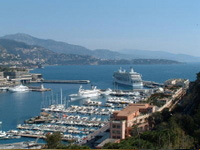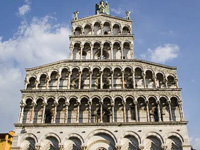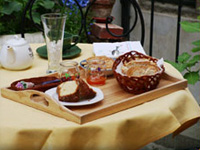Outdoor cafés and the churches of Sant Andrea and S. Anna form the perimeter of Piazza Carrera midway along the narrow Via Roma. At a small table several women dressed in black sit sipping Montecarlo red. On the crest of Cerruglio hill the breeze is refreshing after a warm day touring the treasures of Florence.
 |
Harbor at Montecarlo, Italy |
The tower of S. Andrea struck its bell once for the half-hour reminding us of our early morning departure. To my suggestion that we might consider retiring, my companion replied with a nod to the ladies, “Let’s have another.”
At one end of via Roma where the 14th century Mastio Tower forms the apex of Montecarlo’s triangular ramparts, the wobbly remnants of a wedding party drifted downhill. Looking past the ladies carefully coiffed heads we could see the massive doors of the village gate, Porta Nuova at the other end of via Roma. It is the ‘new door’ because it dates 200 years after the founding of this tiny hilltop fortress village in 1333. We could see both ends of Via Roma, from castle keep to town gate. Montecarlo’s main street is only about 150 meters long.
We chose Montecarlo as our Italian destination partly because it's located conveniently between Lucca, Pisa, and Florence. Following a week of swimming and boating at Santa Margherita near Porto-fino we had drove the two and a half hours south for a cultural infusion. The gastronomic infusion would continue unabated.
Lucca is 20 minutes northwest from Montecarlo. Out the 14th century Poticciola Gate, a right on Via Benevici, and left on Via di Montecarlo brings you past Enoteca Ristorante Fattoria la Torre.
It is not recommended to lunch at Fattoria la Torre before going to Lucca. If you do it justice and enjoy, for example, the tagliatelle al fungi and grilled, garlic dressed beef with Russo locali, you'll be unable to summon the will to continue the short distance downhill to Lucca. So it's best to lunch in Lucca at one the cafes lining the piazza opposite the San Michele church or the small restaurants in the Roman Piazza Anfiteatro.
 |
Facade of San Michele in Foro |
The photogenic facade of San Michele in Foro is a multilayered and columned postcard. Each column is of differently carved stone. Some elaborately designed, some swirls of striped rock, others of intricate or simple geometric patterns, some like straight candy-canes with carved figures at their heads. The façade is crowned, naturally, by angels.
Gladiators once battled in the Piazza Anfiteatro. The discovery of coins from the reign of Emperor Claudius dates it to the late 1st century. Houses, shops and restaurants now frame the open elliptical Piazza of the former amphitheater. Portions of the original Roman walls can be seen on the outer perimeter along the present day Via dell' Anfiteatro.
In both piazzas, the cafes serve a tasty, simple fare of zuppe, pastas, and sausages with good, inexpensive Tuscan wines. An excellent after-lunch exercise is a walk atop Lucca’s wide 16th century wall surrounding the town.
A 45 minute drive southwest from Montecarlo brings you to the Cathedral complex of Pisa and its famous leaning campanile.
The train to Florence leaves from Altopascio, a convenient ten-minute ride to the bottom of the Cerruglio hill. Direct to Florence’s center, it's then a short walk to the Galleria dell'Accademia to meet Michelangelo’s David in all his splendor. Or an equally short walk to Porto Vecchio and the gold shops, to the Uffizi Museum that could easily take your entire vacation to appreciate or to the many other Medicians wonders that are squeezed into Florence.
The Central Market, a large two-storied open hall packed with aromatic, colorful stalls of fresh produce, fruits, nuts, meats and tinned delicacies is a great place to gather a picnic lunch, or collect bags of snacks to enjoy while tramping around the city.
For more substantial dining, Trattoria Il Latini is a local favorite for very good reasons. Servings are huge, service is genial and a large bottle of Chianti waits at each table. The head waiter quickly appears to recommend antipastos while assistant waiters open the wine and pass around plates of mushroom, garlic and tomato bruschetta that quickly disappear.
Altopascio, at the bottom of the hill supporting Montecarlo, is also a small town with a long history. The 11th century Spedale, a convent/hospital, was refuge for pilgrims traveling the Via Francigena to Rome.
We had chosen Montecarlo as well because it is an attractive example of these hilltop fortress villages sprinkled about Tuscany. It is named for Bohemian Prince Charles, later Emperor Charles IV, who began the fortifications of Montecarlo. Portions of the ‘del Cerruglio’ fortress that predates the town remain in the northern walls where the castle's main defensive structures lie. After the Florentines took control in the 1500s, Cosimo I de Medici enlarged the fortifications of Montecarlo.
The walls remain intact and circle the village. Although only a few of the original 15 towers are standing, the northern main triangle of towers and the southern Torre la Rochetta detta 'La Tomba' and Torre Belvedere remain. Along with the Porta Nuova, the 14th century Florentine and Lucca Gates are well preserved.
We had chosen Montecarlo finally because of the Antica Casa dei Rassicurati. The small inn is located across from the Theater dei Rassicurati where Puccini performed. It's also a convenient block downhill from the cafes and restaurants along Via Roma. It's a gem.
 |
Antica Casa dei Rassicurati Meal |
No, that’s not quite right. The accommodations are comfortable, exceedingly charming, clean and quiet (except when the bell tower of the Church of S. Andrea peals its hourly greeting). Miriam, Antonella and Marta, the three hostesses who share hands-on management are the jewels of the Antica Casa dei Rassicurati. Helpful, sincere and welcoming, the three enhance the appeal of their snug hotel. A delicious breakfast of homemade bread, pastries, jams and local fruits with fresh coffee is brought to the outdoor terrace each morning. Every question and request is pleasantly and informatively covered with a genuine eagerness to make it all work out well. And it does - splendidly.
Even the two large tabbies seemed happy with their guests when not dozing among the red geraniums brightening the Casa’s entry. After a day of cultural touring or a relaxing beach day at nearby Marina di Vecchiano, the appetizers and Montecarlo wines brought to the terrace early evening are a fine touch.
Dinner at Cantina Italia in the Piazza Carrera of risotto negro and heaping veal brochettes drowned with Brolio Chianti didn’t completely quench our thirst. After gelato affogato we decided for a last Rosso di Montecarlo before retiring. It is here, after moving to an outdoor café along the Via Roma that we encountered the late night ladies in black.
We had noticed on prior evenings that it was customary for the neighborhood seniors to step out in the very late hours for a sip and to enjoy the cool evening breeze. The twelfth toll from the bells of S. Andrea rang out and our oenophile companions raised their glasses. Tomorrow would be arrivederci but as we shared a toast with the septuagenarian set of Montecarlo, we felt we had chosen well.